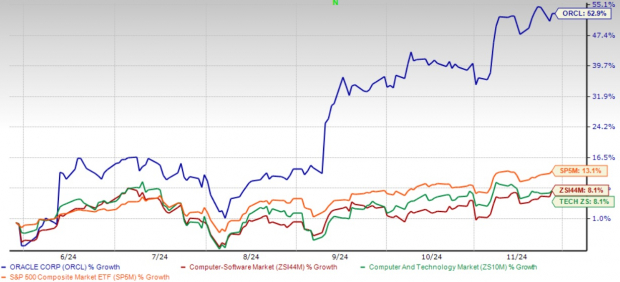Oracle’s Skyrocketing Stock Faces Risk Amidst Dwindling Growth
Over the past six months, Oracle ORCL has surged by 52.9%, greatly surpassing both the Zacks Computer and Technology sector and the S&P 500, which saw gains of 8.1% and 13.1%, respectively. However, this significant increase has raised concerns about the company’s valuation levels.
Recent Price Trends

Image Source: Zacks Investment Research
Currently priced at a high price-to-sales multiple of 8.61X, Oracle stands above the Zacks Computer-Software industry’s ratio of 8.02X. This indicates that investors may be too optimistic about future growth, considering the competitive challenges in the cloud computing sector ahead. This elevated valuation leaves little margin for error and could pose significant risks for investors.
Current Valuation Insights

Image Source: Zacks Investment Research
The Zacks Consensus Estimate forecasts fiscal 2025 revenues at $58.02 billion, equating to a year-over-year growth of 9.55%. Additionally, earnings are expected to rise to $6.20 per share, reflecting an 11.51% increase. These modest figures raise doubts about whether such growth justifies the current elevated stock price. Moreover, a slight increase of only 0.2% in earnings estimates over the last two months indicates limited potential for further gains.

Image Source: Zacks Investment Research
Discover the latest earnings estimates and surprises on Zacks Earnings Calendar.
Cloud Revenue Growth Shows Signs of Slowdown
While Oracle’s management expresses confidence about cloud revenue growth, showing a 22% increase to $5.6 billion, deeper patterns are concerning. The growth rate for Infrastructure-as-a-Service is now at 46%, down from the previous year’s robust 64%. This slowdown might hinder Oracle’s ability to stay competitive in the ever-evolving cloud market.
Capital Spending Raises Concerns
The company plans to double its fiscal 2025 capital expenditures compared to 2024. With first-quarter spending already reaching $2.3 billion and ambitions for substantial data center expansions, Oracle is heavily investing in infrastructure. Such aggressive spending strategies could compress profit margins, especially if anticipated cloud service adoption falls short.
Multi-Cloud Strategy: A Double-Edged Sword
Oracle’s collaboration with Amazon AMZN-owned Amazon Web Services, along with ties to Microsoft MSFT Azure and Alphabet GOOGL-owned Google Cloud, showcases a multi-cloud strategy. However, it could also indicate weaknesses, suggesting Oracle’s cloud platform is not attracting enough independent customers, thus relying on larger platforms for growth.
Financial Performance Raises Eyebrows
The first-quarter results included promising data, such as a 14% increase in operating income and a 43% operating margin. Nonetheless, reliance on accounting adjustments to enhance figures is worrisome. Extending the lifespan of servers from five to six years cut operating expenses by $197 million in the first quarter, artificially boosting perceived profitability.
Monitoring Debt and Cash Flow
Oracle’s cash reserves amount to $11 billion, while ambitious capital expenditure plans could put pressure on its balance sheet. Operating cash flow in the first quarter was $7.4 billion, but intensive capital allocations for expanding data centers might adversely affect free cash flow subsequently.
Identifying Key Risks
Investors should keep an eye on several risks, including potential declines in cloud growth, margin pressures from aggressive spending, and challenges in executing their multi-cloud approach. Additionally, high capital expenditure commitments may restrict financial flexibility if cloud adoption does not align with expectations.
Given Oracle’s lofty valuation at 8.61X sales against lackluster growth rates and significant capital needs, investors may want to reconsider their positions. Waiting for a better entry point, ideally when the price-to-sales ratio reflects the company’s actual performance and market conditions, could be prudent.
Conclusion
In light of Oracle’s high valuation, slowing growth in critical areas, and large capital expenditure commitments, investors are advised to contemplate reducing their stake or exiting altogether. The existing price levels appear to accommodate an overly favorable outlook yet overlook considerable risks. Oracle currently holds a Zacks Rank #4 (Sell).
For a look at today’s top Zacks #1 Rank (Strong Buy) stocks, click here.
Explore Top Stocks for the Near Future
Experts have unveiled 7 top stocks among the current list of Zacks Rank #1 Strong Buys that they believe have great potential for price increases.
Since 1988, this expert-curated list has outperformed the market twofold with an annual average gain of 24.1%. Don’t miss out on these recommended stocks.
Download the latest recommendations from Zacks Investment Research: 5 Stocks Set to Double.
Amazon.com, Inc. (AMZN): Free Stock Analysis Report
Microsoft Corporation (MSFT): Free Stock Analysis Report
Oracle Corporation (ORCL): Free Stock Analysis Report
Alphabet Inc. (GOOGL): Free Stock Analysis Report
For the complete article on Zacks.com, click here.
Zacks Investment Research
The views and opinions expressed herein are those of the author and may not reflect those of Nasdaq, Inc.

